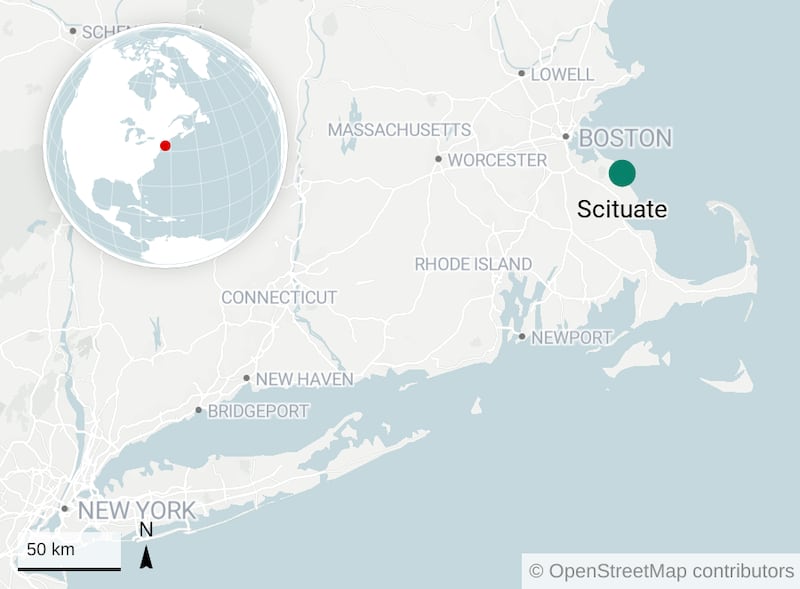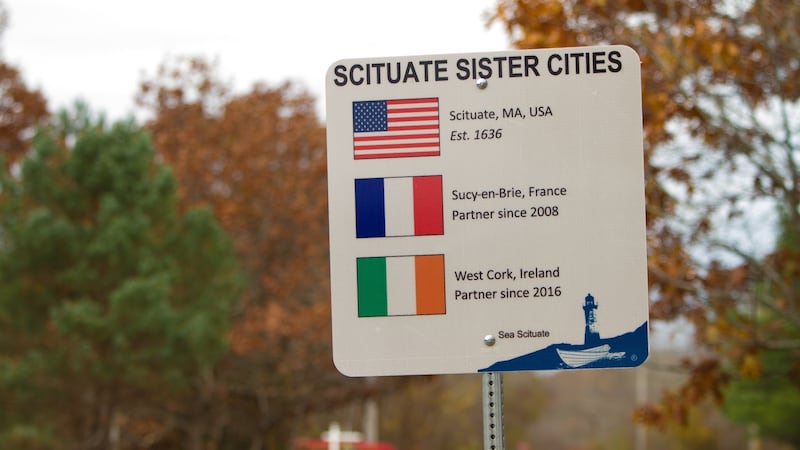Less than an hour’s drive south of Boston, the picturesque town of Scituate comes into view. The coastal town is located about half way between Boston and the tip of Cape Cod, the curved peninsula that swirls into the Atlantic Ocean, drawing holidaymakers from across the state and the country each year.
Scituate also has a particular claim to fame – it is officially designated as the most Irish town in America. Data from the 2010 US census found that the Massachusetts town is home to a higher concentration of people who trace their heritage to Ireland than any other place in the United States.
Arriving in Scituate on this blustery morning, I’m greeted by Brenda O’Connor and members of the Scituate West Cork Sister city committee. As the name suggests, they have recently founded an organisation that is developing links between Scituate and Skibbereen.
When we meet they’re just back from the Taste of West Cork Festival. A visiting delegation from west Cork, led by Mayor of Co Cork Patrick Gerard Murphy, recently visited Scituate for the first time.
“It’s been a really productive few months, and we’ve lots of plans to cement the relationship even further,” explains Brenda, setting out the committee’s plans for further collaboration with west Cork including in the field of food, visual arts and gardening. “For our community, the links with Ireland and that area in particular run deep.”

Looking out across the bay as we meet in the Mill Wharf restaurant, I’m reminded of the west coast of Ireland. Framed by the Old Scituate Lighthouse which dates from 1811, Scituate Harbor stretches out towards the horizon, a string of boats bobbing in the water. As the clouds roll in and the winds whip up, we could be in Kinsale or Skibbereen.
The lighthouse is a poignant reminder of a tragedy that has resonated for decades in this town. In 1849, a Famine ship called the Brig St John which had left Galway Bay ran aground nearby. An estimated one hundred men, women and children were drowned. Parts of the wreck are on display at the nearby Cohasset Maritime Museum and a Celtic high cross was erected in the cemetery there in 1914 by the Ancient Order of Hibernians, one of the oldest Irish American societies in the United States.
Irish moss
Though Scituate was founded in the late 17th century, its development as an Irish town dates back to the wave of Irish emigration to America in the 19th century when Boston fisherman Daniel Ward discovered carrageenan – otherwise known as Irish moss – growing beneath the rocks near Scituate’s shore.
A new industry was born, and Irish mossing took off as a thriving business, with the dried moss being shipped off to be used in products such as beer, paint and cosmetics, an activity that continued until recent decades.

This trend of Irish Bostonians moving south to Scituate repeated itself in different ways through successive generations.
The second big wave of Irish immigrants arrived in the early 20th century. Many Irish Bostonians who were becoming more affluent, holidayed in Scituate and surrounding towns. The population doubled and the area became known as the “Irish Riviera”.
Brenda O’Connor’s family was one of this generation. “My grandmother emigrated from Ireland with her brother Patrick when she was 13. They lived in Roscommon, just outside Athlone and were sent to America,” she recalls.
She and her brother first arrived in New York where they were met by a cousin, before moving north to Boston. It took them two years to pay off their fare.
Like many new Irish arrivals, she worked as a maid for established New England Protestant families known as the Yankees. “But she worked hard,” says Brenda. “She made three dollars a week – one dollar was sent home to Ireland, one dollar to the church, 90 cents went in the bank and the remaining 10 cents were for tea and cake with her friends on her half day off.”
After meeting and marrying another Irish immigrant, Michael Donohue, who had in fact grown up seven miles away from her in Ireland, she took in laundry and saved enough money to buy a piano and ensured her children got an education.
‘Very ambitious’
“Many of the Irish who arrived were very ambitious,” says Brenda. “The immigrant’s job was to educate the next generation so they would do better, and their job in turn was to make sure the next generation did better again. That pattern continued – the first generation were often the policemen, the firemen, the second generation the lawyers, the doctors.”
It was in this context of growing affluence that Ellen Kelly’s family and many Irish Bostonians began to take houses on the South Shore in the 20th century.
Breaking social barriers for the Irish-Americans was not always easy, however. Famously, Joe Kennedy, the father of John and Bobby Kennedy, was refused membership of Cohasset golf club, a few miles from Scituate, in 1922 because he was Catholic. As a result he moved his family further south to Hyannis Port for summer vacations, forever entwining the southern tip of Cape Cod with the Kennedys.

But while Brenda O' Connor grew up in a staunchly Irish family, where she was educated about Irish history from a young age and was taught songs like the Wearing of the Green and God Save Ireland, other residents of Scituate were less aware of their heritage.
As local attorney John Sullivan explains as he brings me on a tour of the town, being Irish was standard in this part of the world. “Everybody had Irish names, everybody was Catholic,” says John who also has Italian heritage on his mother’s side.
It was only when he visited Ireland himself with his brother in 1993 that he really connected with his Irish heritage. “That’s when so much crystallised for me. What they say is true. Once your feet touch Irish soil you never lose the connection.”
He is now a member of the Ancient Order of Hibernians and is actively involved in Easter Rising commemorations in the town.
Family names
As we explore the town, traces of Irishness are imprinted everywhere. As in Ireland many of the businesses are known by their family names, an unusual trope in America. Irish names adorn the shopfronts – Reynolds’ Packages, Jack Conway Realtors, Murphy/Carty Insurance.
The election posters for November’s elections fluttering in the breeze are testimony to the area’s Irish roots. “Elect Ed O’Connell,” says one, “Vote Kearney” says another, a reference to local man Patrick Kearney, who defeated Sean Costello in the Democratic Primary for the state elections.
As we drive out to the lighthouse many of the pretty beach houses have Irish names above their doors – Murphy, Burke, McLaughlan, Egan.
While many of the Irish residents here trace their heritage back generations, there has also been more recent immigration to the area from Ireland.
Brian Houlihan hails from Ballincollig in Co Cork. He moved to the United States more than 20 years ago, having trained as a chef in Ireland. He initially honed his experience and worked as sous chef of the Four Seasons in Boston and executive chef of the Bostonian Hotel. Fifteen years ago he moved south from Boston and opened his first restaurant near Scituate. He now has four restaurants in the area.
Here in his recently renovated Bia Bistro on a Friday night, the atmosphere is buzzing. Locals and tourists crowd into the cozy restaurant. Over oysters and French-inspired entrées, he pops out of the kitchen and tells me about his business and life in this part of the United States.

“I think I’ve brought a lot of my training in Ireland with me – the importance of good, locally-sourced ingredients, the value of creating a good space for people to chat, to interact, to enjoy the food.”
Though he has built a life in the United States, he keeps in close contact with Cork. He recently returned from the Taste of West Cork festival.
The symbols of Irishness in the restaurant, are evident but subtle – the Jameson whiskey bottle alongside the array of cocktail offerings at the bar, the Irish cheddar on the menu.
Second nature
Amid the deluge of shamrocks and green chintz that characterises many Irish bars and restaurant in the United States, it’s a welcome change.
But this need not to advertise its Irishness is part of the charm of this region of Massachusetts where Irish identity is so entrenched it’s second-nature.
At a time when Irish emigration to America has slowed down considerably, Scituate is a reminder of the vibrant role Irish emigration played in shaping communities across the US, and the unique cultural mix and distinctive Irish-American identity it engendered.
As Niall O’Dowd, editor of irishcentral.com, points out, Ireland is in danger of losing its diaspora in the coming decades. “At one point the Irish were pouring in at the rate of 20,000 a month, now a few thousand a year come legally,” he says.
O’Dowd believes that within a generation fewer Americans will have close links to Ireland or will be brought up in homes where there was any first-hand experience of Ireland.
This presents a challenge for the government. “You have to work at a diaspora. Diasporas can die,” he says, citing the example of Germany, which has seen German-American identity fade despite historically high levels of immigration to the US from Germany.
In this context, the government and special envoy John Deasy’s recent efforts to try and secure E3 visas, a new category of visas currently only open to Australians, for Irish citizen is welcome, he says.
For towns like Scituate, however, the connections with Ireland are as strong as ever. As Brenda O’Connor looks out at the Atlantic, she reflects on how her Irish heritage remains such an important party of her identity.
“Ireland remains an important part of who we are in this part of the world. Hopefully through our links with west Cork we can help maintain those connections for future generations. Irish identity is in our blood.”













